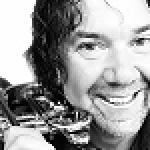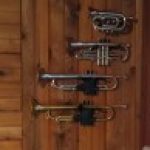WindWorks Trumpet Academy › Forums › WindWorks › Just a little thought about changing pitch!
Tagged: Changing pitch, harmonic slurs.
- This topic has 5 replies, 5 voices, and was last updated 5 years, 3 months ago by
 Daniel OLeary.
Daniel OLeary.
-
AuthorPosts
-
-
22 April 2019 at 7:29 pm #21886
 fmaziersParticipant
fmaziersParticipantHey Greg,
For changing pitch (or speed of the air) you have two solutions:
1) you stay with the same mouth configuration thanks to the contraction of the muscles of the mask (and some other things that make it easier, in particular the use of the tongue), and you vary the compression of the air thanks to the work of the expiratory muscles.
or
2) you keep the same compression by the same work of the expiratory muscles but you change the configuration of the mouth to change the size of the exit hole and thus varying the air speed.
And so, as our genius Estein said, everything is relative.
To learn the trumpet it seems that you recommend to work according to schema 2 while the majority advocates the schema 1.
Can you explain to me your choice?
My very sincere friendships. -
24 April 2019 at 8:39 pm #22129
 Greg SpenceKeymaster
Greg SpenceKeymasterHey Francis, thanks for your wonderfully thought out question.
There are many variables involved in your question.
As you would have seen in SPS Screech Pedals, what people think they are doing vs what is really happening comes to mind. Also the psychological impact of solution 1 is more often than not extremely destructive.
Firstly “the speed of air for pitch change” is a terrible psychology. This suggests “blowing faster” to play higher. As I have demonstrated throughout the course, this is not the case.
There is the speed of oscillation of the air column which is pitch determined by the aperture and then there is the amount of flow which is the amount of displacement per/sec which requires one to support the airflow faster.
This is murky and complicated. Telling someone to blow faster to change pitch creates all kinds of over exertion issues.
Keeping the flow steady, changing SHAPE and then gradually adding volume to an efficient system creates efficient habits.
Solution 1. Suggests playing the note at the same volume. The “contraction of the muscles of the mask” will stimulate the pitch change. The compression of the air thanks to the expiratory muscles is the volume.
Solution 2.
“Changing the configuration of the mouth with the same compression” will result in higher pitches but the volume will be decreased; see how the two solutions are not actually going to achieve the same outcome?!The reason for my approach? Learning the correct “configuration” i.e. SHAPE allows the student to efficiently find the pitch.
Teaching a student to blow faster with no awareness of SHAPE requires massive force to blow or force the lips into the required configuration. This is generally a futile approach.
My approach? Find pitch, add volume.
As the Singing C suitably demonstrates, you can discover an extremely high register with the only exertion from the body being that of the inhalation.
The speed of air (the amount per second: blow faster) is volume.
The speed of oscillation of the air column, determined at the aperture is the frequency/pitch.
All I really care about is the psychological impact a suggestion or command has on a student.
I spend my life re-teaching people who are looking for “solutions” by blowing harder to back off and play efficiently then change SHAPE to find notes they have never been able to find due to overblowing and the resulting pinching the lips, or vice versa.
Cheers.
-
25 April 2019 at 5:00 am #22174
 fmaziersParticipant
fmaziersParticipantSo if I understand you correctly it is better to change the shape first and then adjust the volume to learn to be well “placed” and not the opposite even if ultimately we arrive at the same result for pitch and intensity of the sound?
ABSOLUTELY!!! 🙂
-
27 April 2019 at 1:21 am #22402
ab-hoffman
ParticipantI have been teaching private lessons for years and have some thoughts on this subject. Many students come to me having been told by well meaning band directors to just blow harder or faster to achieve an upward lip slur. This works up to a point, but the resulting sound is loud and wild or raucous. These students have no concept of aperture corners and can’t begin to play softly. When range is a problem their well meaning teacher will tell them to tighten their lips and they proceed to clamp down at the center and close off the aperture, resulting in a pinched, thin sound. These students often develop throat closure problems, which is difficult to overcome.
I agree with Greg in that the impact of a command can have negative effects on a students development and that is why I appreciate Greg’s well thought out instructional sequence and have been using it in my own teaching. I sometimes don’t understand when others coming from other methodologies disagree so strongly with Greg’s ideas, as I see many similarities in all schools from Bill Adam, James Stamp, Claude Gordon and others. I just see it as different ways of getting at the same result.
Thanks for this reply! To me it just seems so logical and obvious yet people can get riled up by even the smallest reference to lips or tongue let alone what to do with air. Oh well, continue fighting the good fight 🙂 -
27 April 2019 at 3:45 pm #22427
johnelwood
ParticipantI’ve been struggling again after having switched to a shallow mouthpiece.
Things were going brilliantly and I was feeling very confident when all of a sudden, little by little my range began going backwards to where I had little flexibility and high C, which had became a given–a note I could control almost as good as any other, was no longer a given.
Long story short, I realized that for some reason I had begun slightly tightening my lips top to bottom rather than from the sides (aperture corners). It was a very subtle thing, but had a huge impact.
As soon as I went back to focusing on Ooooh and the corners, I popped back into what excited me about the shallow mouthpiece to begin with–how it almost is as if the wider you open the aperture, the better the sound–even high up above the staff.
I’m hoping for more success tomorrow and getting back towards an upward trend again.
It’s funny (scary) how easily we can revert back into old habits and accidentally begin reinforcing those bad habits–I believe I had been practicing incorrectly for a number of days in a row without realizing it and that’s what my problem was.
I had gotten busy at work and only had time for a warm up, some lip slurs / harmonic slurs up as far as I could go and maybe a few scales.
I believe if I was focusing just on air, like some recommend, I would continue to be lost–just as I was from age 8 when I started playing until age 22-25 when I gave up trying to have a range.
While I still battle and have had another backslide, it’s when I focus on the aperture corners, oooh/ahhh, resonant sound, open throat, etc. that I play my best / feel like I’m progressing.
-
28 April 2019 at 4:12 am #22476
 Daniel OLearyParticipant
Daniel OLearyParticipantFor me it isn’t one way or the other it’s where we are placing our emphasis.
Take for example the first drill in each key, passive tonguing , which I find to be the most difficult one to execute properly.
I’ll blow air balls on the top note I’m trying to tame till the cows come in for milking if I don’t ” kick ” it a few times to get the motor running.
Of course just like my old motor bike I no more kick it over and get it running on both cylinders than it dies and I have to kick start again a time or 2 till it warms up and I can go on to the next drills where both approaches are utilized and developed.
-
-
AuthorPosts
- You must be logged in to reply to this topic.
Recent topics
-
Question of Curiosity – To Teeth or Not To Teeth
by
clawsonk123
1 month, 3 weeks ago -
1.O / 2.0 routine
by
jice.gif
2 months, 3 weeks ago -
Abdominal surgery and time off the trumpet
by
DQ
9 months, 3 weeks ago -
Allegro or Presto Practice Routine
by
djm297
10 months, 2 weeks ago -
Tongue lock – Throat lock
by
Ivo Carrabs
11 months, 1 week ago
